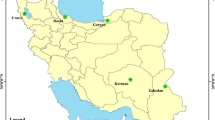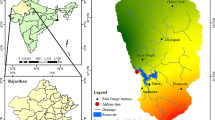Abstract
In the recent years, artificial intelligence techniques have attracted much attention in hydrological studies, while time series models are rarely used in this field. The present study evaluates the performance of artificial intelligence techniques including gene expression programming (GEP), Bayesian networks (BN), as well as time series models, namely autoregressive (AR) and autoregressive moving average (ARMA) for estimation of monthly streamflow. In addition, simple multiple linear regression (MLR) was also used. To fulfill this objective, the monthly streamflow data of Ponel and Toolelat stations located on Shafarood and Polrood Rivers, respectively in Northern Iran were used for the period of October 1964 to September 2014. In order to investigate the models’ accuracy, root mean square error (RMSE), mean absolute error (MAE) and coefficient of determination (R2) were employed as the error statistics. The obtained results demonstrated that the single AR and ARMA time series models had better performance in comparison with the single GEP, BN and MLR methods. Furthermore, in this study, six hybrid models known as GEP-AR, GEP-ARMA, BN-AR, BN-ARMA, MLR-AR and MLR-ARMA were developed to enhance the estimation accuracy of the monthly streamflow. It was concluded that the developed hybrid models were more accurate than the corresponding single artificial intelligence and time series models. The obtained results confirmed that the integration of time series models and artificial intelligence techniques could be of use to improve the accuracy of single models in modeling purposes related to the hydrological studies.







Similar content being viewed by others
References
Abdollahi S, Raeisi J, Khalilianpour M, Ahmadi F, Kisi O (2017) Daily mean streamflow prediction in perennial and non-perennial rivers using four data driven techniques. Water Resour Manag 31(15):4855–4874
Ahani A, Shourian M, Rahimi Rad P (2018) Performance assessment of the linear, nonlinear and nonparametric data driven models in river flow forecasting. Water Resour Manag 32(2):383–399
Behmanesh J, Mehdizadeh S (2017) Estimation of soil temperature using gene expression programming and artificial neural networks in a semiarid region. Environ Earth Sci. https://doi.org/10.1007/s12665-017-6395-1
Box GE, Jenkins GM (1976) Time series analysis. Forecasting and control. Holden-Day, San Francisco
Danandeh Mehr A, Kahya E (2017) A Pareto-optimal moving average multigene genetic programming model for daily streamflow prediction. J Hydrol 549:603–615
Ferreira C (2001) Gene expression programming: a new adaptive algorithm for solving problems. Complex Syst 13(2):87–129
Ghorbani MA, Ahmad Zadeh H, Isazadeh M, Terzi O (2016) A comparative study of artificial neural network (MLP, RBF) and support vector machine models for river flow prediction. Environ Earth Sci. https://doi.org/10.1007/s12665-015-5096-x
Goyal MK, Bharti B, Quilty J, Adamowski J, Pandey A (2014) Modeling of daily pan evaporation in sub tropical climates using ANN, LS-SVR, fuzzy logic, and ANFIS. Exp Syst Appl 41(11):5267–5276
Hsu KL, Gupta HV, Sorooshian S (1995) Artificial neural network modeling of the rainfall-runoff process. Water Resour Res 31(10):2517–2530
Humphrey GB, Gibbs MS, Dandy GC, Maier HR (2016) A hybrid approach to monthly streamflow forecasting: integrating hydrological model outputs into a Bayesian artificial neural network. J Hydrol 540:623–640
Huo Z, Feng S, Kang S, Dai X (2012) Artificial neural network models for reference evapotranspiration in an arid area of Northwest China. J Arid Environ 82:81–90
Kalteh AM (2013) Monthly river flow forecasting using artificial neural network and support vector regression models coupled with wavelet transform. Comput Geosci 54:1–8
Kisi O (2011) A combined generalized regression neural network wavelet model for monthly streamflow prediction. KSCE J Civil Eng 15(8):1469–1479
Kisi O, Cigizoglu HK (2007) Comparison of different ANN techniques in river flow prediction. Civil Eng Environ Syst 24(3):211–231
Kisi O, Cimen M (2011) A wavelet-support vector machine conjunction model for monthly streamflow forecasting. J Hydrol 399(1–2):132–140
Lima AR, Cannon AJ, Hsieh WW (2016) Forecasting daily streamflow using online sequential extreme learning machines. J Hydrol 537:431–443
Maier HR, Dandy GC (2000) Neural networks for the prediction and forecasting of water resources variables: a review of modelling issues and applications. Environ Model Softw 15(1):101–124
Makkeasorn A, Chang NB, Zhou X (2008) Short-term streamflow forecasting with global climate change implications – a comparative study between genetic programming and neural network models. J Hydrol 352(3–4):336–354
Mehdizadeh S (2018) Assessing the potential of data-driven models for estimation of long-term monthly temperatures. Comput Electron Agric 144:114–125
Mehdizadeh S, Behmanesh J, Khalili K (2017) A comparison of monthly precipitation point estimates at 6 locations in Iran using integration of soft computing methods and GARCH time series model. J Hydrol 554:721–742
Mehdizadeh S, Behmanesh J, Khalili K (2018) New approaches for estimation of monthly rainfall based on GEP-ARCH and ANN-ARCH hybrid models. Water Resour Manag 32(2):527–545
Ni Q, Wang L, Ye R, Yang F, Sivakumar M (2010) Evolutionary modeling for streamflow forecasting with minimal datasets: a case study in the west Malian River, China. Environ Eng Sci 27(5):377–385
Ozgoren M, Bilgili M, Sahin B (2012) Estimation of global solar radiation using ANN over Turkey. Exp Syst Appl 39(5):5043–5051
Rasouli K, Hsieh WW, Cannon AJ (2012) Daily streamflow forecasting by machine learning methods with weather and climate inputs. J Hydrol 414-415:284–293
Ravansalar M, Rajaee T, Kisi O (2017) Wavelet-linear genetic programming: a new approach for modeling monthly streamflow. J Hydrol 549:461–475
Salas JD, Delleur JW, Yevjevich V, Lane WL (1980) Applied modelling of hydrological time series. Water Resources Publications, Littleton
Samsudin R, Saad P, Shabri A (2011) River flow time series using least squares support vector machines. Hydrol Earth Syst Sci 15:1835–1852
Sanikhani H, Kisi O (2012) River flow estimation and forecasting by using two different adaptive neuro-fuzzy approaches. Water Resour Manag 26(6):1715–1729
Santos CAG, Silva GBL (2014) Daily streamflow forecasting using a wavelet transform and artificial neural network hybrid models. Hydrol Sci J 59(2):312–324
Shiri J, Kisi O (2010) Short-term and long-term streamflow forecasting using a wavelet and neuro-fuzzy conjunction model. J Hydrol 394(3–4):486–493
Shiri J, Keshavarzi A, Kisi O, Karimi S (2017) Using soil easily measured parameters for estimating soil water capacity: soft computing approaches. Comput Electron Agric 141:327–339
Taormina R, Chau KW, Sethi R (2012) Artificial neural network simulation of hourly groundwater levels in a coastal aquifer system of the Venice lagoon. Eng Appl Artif Intell 25(8):1670–1676
Thomas HA, Fiering MB (1962) Mathematical synthesis of stream flow sequences for the analysis of river basin by simulation. Harvard University Press, Cambridge 751pp
Wood EF (1980) Real time forecasting control of water resource systems. Workshop Report. Pergamon Press, New York
Yan H, Zou Z, Wang H (2010) Adaptive neuro fuzzy inference system for classification of water quality status. J Environ Sci 22(12):1891–1896
Yassen ZM, Ebtehaj I, Bonakdari H, Deo RC, Danandeh Mehr A, Mohtar WHMW, Diop L, El-Shafie A, Singh VP (2017) Novel approach for streamflow forecasting using a hybrid ANFIS-FFA model. J Hydrol 554:263–276
Zhang X, Peng Y, Zhang C, Wang B (2015) Are hybrid models integrated with data preprocessing techniques suitable for monthly streamflow forecasting? Some experiment evidences. J Hydrol 530:137–152
Author information
Authors and Affiliations
Corresponding author
Ethics declarations
Conflict of Interest
None.
Rights and permissions
About this article
Cite this article
Mehdizadeh, S., Kozekalani Sales, A. A Comparative Study of Autoregressive, Autoregressive Moving Average, Gene Expression Programming and Bayesian Networks for Estimating Monthly Streamflow. Water Resour Manage 32, 3001–3022 (2018). https://doi.org/10.1007/s11269-018-1970-0
Received:
Accepted:
Published:
Issue Date:
DOI: https://doi.org/10.1007/s11269-018-1970-0




